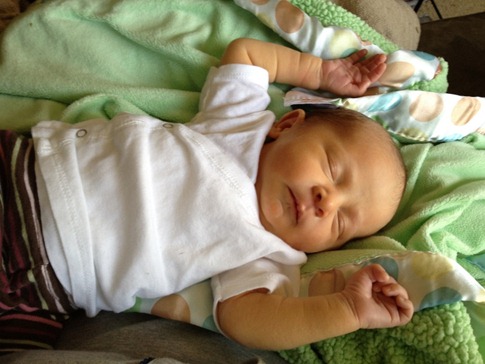As hard as it is to believe that our daughter is already 2 months old, it seems even less likely that we’ve only been parents for 2 months. No, I’m not saying this all seems like old hat to us, just that it’s hard to remember a time when we didn’t have this little creature living with us. And even before she showed up, we’d had extensive conversations about what kind of parents we wanted to be; This with full acknowledgment that it was completely possible we had no idea what we were in for and would soon find ourselves bribing our kids out of tantrums at Walmart and letting them run free in restaurants. Of course, those particular challenges are still a few years down the road, but we definitely find ourselves frequently evaluating the relationship we want to have to our child and how that affects our behavior as parents.
Writer Gary Janetti tweeted something the other day that pretty much sums it up: “What a fascinating story about being a new mom!” No link. No reference to anything. It’s just that everyone thinks their parenting saga is the most fascinating thing in the world; And it is to them. I heard a statistic once that new parents make up the largest sector of applications for new patents. There aren’t many other things that such a large percentage of the population all goes through – many more than one time – and everyone’s got strong opinions on the best way to do it. In fact, that was the subject of one of the most shared “fascinating stories about being a new mom” that appeared on Facebook recently. If you’ve got friends who are parents – or have parents – you probably saw it. The title of the linked blog post was “Don’t Carpe Diem” and began by recounting a story of an older woman stopping a new mom and telling her to cherish every second she has with her child – every second – and how, in no other aspect of life, has it become appropriate to approach strangers on the street and give them unsolicited advice about personal issues. She goes on to write about the pressure this advice imposes, that she’s not a good parent if she’s not enjoying every second that her little one is peeing in the corner of a Target. Ann and I have gone into parenting knowing that we can’t possibly enjoy every second of it, and to some extent, that takes the pressure off so, ironically enough, we feel like we can actually enjoy more of it.
[BEGIN MANDATORY REFERENCE TO OVERLAND TRAVEL TO REMIND OURSELVES (AND OTHERS) THAT WE USED TO BE COOL AND ADVENTUROUS]: We actually took the same approach to our 5 month drive from San Francisco to Panama, knowing that the trip would have its emotional, physical and logistical ups and downs and accepting them as they came.
The other popular link being shared by parents lately is “Why French Parents Are Superior,” an essay by the author of the book “Bringing Up Bebe,” that looks at the differing parenting styles in the US and France. While many American parents seem to think they are giving their child everything they could possibly need or want with myriad toys, activities, creative freedom and immediate and limitless attention, the French approach focuses more on the development of patience and adaptability. A response to the article in Forbes entitled “Bringing Up Bebe? No Thanks I’d Rather Raise a Billionaire” tries to link the glut of experience and lack of boundaries with the much higher number of children who go on to be billionaires. In fact, the author may be right, but I think it says less about the billionaires themselves and more about the culture of “now, now, now” in the US that swallows up the products and services created by them, sometimes literally: Fast food, processed food, meals on the run. Ann and I were in France the summer of 2010 on a motorcycle loop from Nice to the Pyrenees and down the spine of the Alps. We’d get strange looks just carrying a cup of coffee or a croissant down the street rather than enjoying them over a couple hours at a tiny wrought iron café table on a cobblestone square. Regardless of how you interpret the billionaire argument, I think the happiness of the child - and the parents! - is much more telling, and the original author observed a complete lack of tantrums among French children at restaurants and playgrounds and quoted a 2009 Princeton study that found that American mothers considered it twice as unpleasant to deal with their children as their French counterparts. The takeaway for me from the articles was that – despite the impression I’m giving you the reader from this blog post though I promise the next one will be full of farmy goodness – life as a parent does not have to and should not revolve completely around the child. That sometimes, the best thing you can do for their development is focus on being a well-rounded and independent person yourself and teach them to respect that in themselves and others.
“So no, Wynne, now is actually not a good time for me to have you cry or need your diaper changed. I need to be at my computer working on the blog and writing about elements of parenting I’m completely unqualified to be spouting on or doing other important things.”
On the contrary, they say there’s really nothing you can do to spoil a newborn. When they cry, you hold them; when they want to eat, you feed them; and when they’re tired, you put them to sleep. Let’s see, what else do they do? Yep, that’s about it. And that’s been our last two months. While she’s gone from weeks 1-3 with a blurry stare, usually just over your shoulder where your shirt contrasts with the wall behind it, to weeks 4-6 and brief periods of eye contact to tracking objects across her field of vision and most recently to weeks 7-9 for a responsive smile, we’ve gone from weeks 1-3 and checking her breathing on a minute by minute basis and making sure that no material - no matter how porous – comes within 6 inches of her mouth or nose to weeks 4-6 and realizing that hard cartilage in her button nose is designed to keep her airway open while she stuffs as much boob into her tiny mouth as possible to weeks 7-9 and allowing her to burrow her face into our chests as if she’s actively trying to end it all. There’s just nothing like on-the-job training; For Wynne, with each new day representing a large chunk of her life so far, and us, trying to respond to the signals she’s giving us and to stay one step ahead.
While we swore we’d not subscribe to any one method and just do what felt right, one book that really seemed to make sense to us was “Healthy Sleep Habits, Happy Child.” I’ll admit that I was a little shell-shocked by the stories I’d heard from friends; I mean the term “sleep deprived” is pretty much synonymous with new parents. So in the last month before the baby was due, I would read a little of this book each night before going to bed. And in addition to the fact that it tended to be very effective in putting me to sleep, I also learned that the author’s contention is that a well-rested baby is a happy baby. This means that for the first month or so, after any period of wakefulness of about one hour, they should be encouraged to get the sleep they need with rocking or soothing or whatever works. Of course, this can be terribly hard when you have this adorable little person you’ve been waiting to meet for nine months (or possibly your whole life) who now has her eyes open and is looking at you (or just over your shoulder) with what you can only interpret as unconditional love. Now it helps that Wynne seems to have read the same book, because as soon as we’d see the first signs of a fuss – and I mean a tiny squeak of discontent – we’d shut her down into sleep mode, and she would wake up an hour or so later perky and curious. The counter intuitive thing about this technique is that it would seem that the baby who sleeps for much of the day would then not be tired enough to sleep at night. In the author’s experience - and ours following his advice - the baby actually sleeps better at night because she’s calm and happy rather than frazzled and exhausted.
So far, he two most effective methods for nap times have been wrapping her in a fuzzy blanket and rocking in a chair, dubbed “The Snow Princess”…
And the Ergo Baby Carrier with the burrito-like infant insert we call “The Sleep Maker.”
From the beginning, we also imposed a strict “bright lights and loud noises” policy for that daytime sleep. With the exception possibly of the few minutes while she was settling, we would keep her in a well-lit room and use our full voices. As much as this was for our convenience, we’d also read that it helps establish the difference between day and night time sleeping patterns. The only downside was the startle reflex that we called the “Surprise Kitty.”
While it didn’t usually wake her up, it made for some entertaining sleeping positions…
“The Sorcerer”
“The Milk Drunk”
“The Sensei”
But unique sleeping positions are par for the course for this little girl…
Everyone always asks us how Gorilla is doing with the new addition in the house. She definitely comes running when we use the “baby voice” that used to be reserved for her, but as long as she has a spot on the couch with the family, she’s happy.
Plus there are perks like riding in the front seat of the car (where there are seat warmers) and a few more nights where we take pity on her and invite her to curl up with us on the bed.
Now at two months old, Wynne’s really starting to become a little person. Sure, she can’t support her head on her own and if you put her on her back she wriggles around like an upended turtle, but she’s making eye contact, smiling and when we look at her, participating in long “cooing” conversations, and entertaining herself (and us) with the first signs of realization that her hands and feet are attached to her. The best is when we pick her up from the bouncy chair and find that she’s clenched her fist onto one of the straps. We can’t lift her until she lets go, but she’s looking at us like “What’s the problem here?”
At around 7:30 each night, she starts squawking a little and Ann will take her upstairs to nurse and lie in the bed. About an hour later, she’s descended into full on nighttime sleep mode, and Ann can bring her limp form downstairs for a couple hours of clearing off the Tivo. Through the night, she stirs every two to three hours from her position either on a concave pillow between us or nestled in the crook of Ann’s arm. After a quick feeding, she dozes back off. At 8 am she’ll open her eyes from a sleepy fuss – let’s face it, none of us has an easy time waking up – to be the happiest, most content baby in the world, smiling and stretching for half an hour while slowly remembers each new skill and sense she developed in the days before.

























